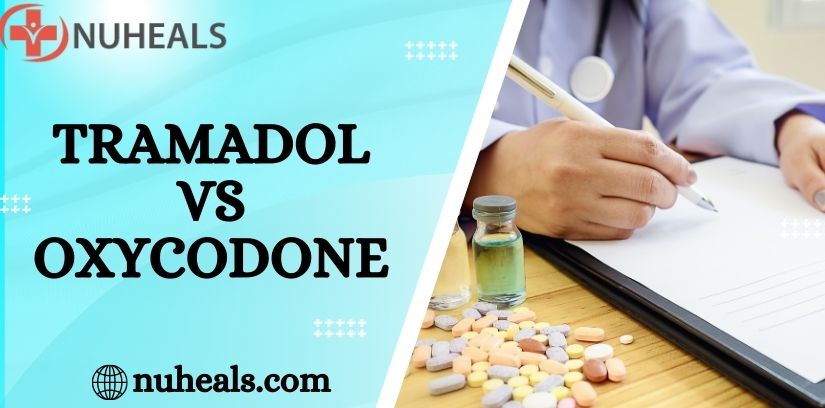Whenever in pain, you must have heard of the drugs tramadol vs oxycodone. They both are used as painkillers by the people of the USA. Both drugs belong to the category of opioid analgesic medicines, which alleviate moderate to severe pain.
If your doctor has prescribed you any of these medicines, and you want to know the difference between them, you are on the right article.
COMPARISON BETWEEN TRAMADOL AND OXYCODONE
Tramadol
Tramadol is an opioid medicine, approved by the FDA to treat moderate to severe pain in adults. Due to its potential for misuse and addiction, it is classified as a Schedule IV controlled substance by the DEA. It is sold under several brand names like Ultram, Ultram ER, Conzip, and also as a generic drug.
It comes in the form of immediate-release (IR) oral tablet, extended-release (ER) oral tablet, and ER oral capsule.
Oxycodone
The FDA approves Oxycodone, but the only condition is that it should have a special coating, making it hard to inject, crush, or snort to reduce its misuse. It is a Schedule II controlled substance in the US due to its high chances of abuse and addiction.
Oxycodone is available in two forms – immediate release (IR) oral tablet and controlled release (CR) oral tablet. It comes in several brand names like OxyContin, Roxicodone, Percocet, etc.
Mechanism of Action
Tramadol blocks the pain from reaching the brain. Though it is a weak opioid pain drug, it influences pain perception in the brain. It binds to mu-opioid in the central nervous system (CNS) like other opioid drugs.
Tramadol
By increasing the levels of serotonin and norepinephrine it helps in modulating the pain signals. Its dual mechanism gives a weaker but broader approach to pain relief.
Oxycodone
Oxycodone effectively blocks pain signals from reaching the brain by binding the opioid receptors in the central nervous system. It has a strong binding capacity and stronger pain relief effect compared to the tramadol drug.
By directly targeting the pain signal it provides a stronger pain relief mechanism.
Uses
Tramadol
Tramadol is a pain relieving medication, typically not the first choice because of its side effects and long list of potential threats. It is administered to people who can’t take other pain drugs like strong opioid pain drugs or nonsteroidal anti-inflammatory drugs (NSAIDs).
Oxycodone
It is used as a drug to treat mild to severe pain in patients. This could be post injuries, surgery, or other chronic pain conditions like severe arthritis, cancer, etc. when other medicines don’t work effectively.
Doses and Dosages
Tramadol
IR oral tablets –
- 50 mg
ER, oral tablets –
- 100 mg
- 200 mg
- 300 mg
ER, oral capsules –
- 100 mg
- 150 mg
- 200 mg
- 300 mg
Oxycodone
IR oral tablets –
- 5 mg
- 10 mg
- 15 mg
- 20 mg
CR oral tablets –
- 10 mg
- 15 mg
- 20 mg
- 30 mg
- 40 mg
- 60 mg
- 80 mg
The medicines should be taken only as per the doctor’s recommendation. Depending on the patient’s medical history, needs, age, weight, and other factors the doctor administers the dosage of the drug. They start from the minimum dose and increase it gradually to reduce the chances of serious aftereffects.
Side effects
Tramadol
Common side effects
- Tiredness
- Nausea
- Heartburn
- Constipation in people above the age of 70
- Dizziness
- Headache
- Rashes on the skin and itching
- Dry mouth
- Joint pain
- Stuffy nose and sore throat
Severe side effects
- Decreased appetite
- Body pain
- Night sweats
- Blood in the urine and painful urination
- Feeling hot
- Trouble in sleeping
- Congestion in the ear
- Excessive gas
- Loss of sexual ability
- Bladder pain
- Seizures
Oxycodone
Common side effects
- Nausea
- Constipation
- Pain in the head
- Skin rash and irritation
- The feeling of spinning (vertigo)
- Feeling tired
- Stomach discomfort
- Red eyes
Severe side effects
- Difficulty in breathing
- Swelling in the face, tongue, throat or nose
- Weak pulse, or slow heart rate
- Seizure
- Cold Skin
- Sleep apnea
If you experience any of these aftereffects, immediately consult your healthcare provider.
Precautions
Here are some precautions you should follow while consuming the drugs tramadol or oxycodone.
It can form a habit if used for a prolonged period.
Medicine should not be prescribed to:
- Children under the age of 12 years
- Obese children between the ages of 12 and 18 years
- Pregnant or breast-feeding women
- People over the age of 65 years
- Individuals with a medical history of seizures, brain injury, asthma, lung diseases, brain tumors, etc.
- People who tend to commit suicide.
Ask your health provider for the list of prescribed and non-prescribed medications, vitamins and nutritional supplements to be taken with tramadol or oxycodone.
Avoid alcohol as well as drugs that contain alcohol when taking tramadol or oxycodone.
You can experience withdrawal symptoms like insomnia, anxiety, nausea, piloerection, diarrhea, etc. if you are taking the medicine for a long time and stop abruptly. It is better to minimize the dosages as prescribed by the doctor.





